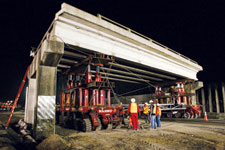 |
| Extradosed. New I-95 crossing in New Haven will sport hybrid design technique adopted from Japan. (Rendering courtesy of URS) |
When URS Corp. area bridge manager Dave Stahnke visited Japan in 2001 to learn more about the technique of “extradosing,” the irony did not strike him until later. “Here we were in Japan gathering information for the Pearl Harbor Memorial bridge” in New Haven, he recalls. As the Interstate highway system marks its 50th year, former enemies at its infancy now are sharing bridge technology.
More than good karma, the extradosed design—a combination of segmental girder and cable-stayed elements— for the Interstate 95 “Q” Bridge represents the innovation and experimentation that will mark the second 50 years of U.S. highway building. Like the Six-Million-Dollar Man, the Interstate will be built “better...stronger...faster.”
Whether it is off-site fabrication, movable barriers, “hyperfix” rehabilitation or new bridge methods, the mandate is clear. “The idea is, how to do what we need to do on roads safer, faster and to last longer,” says J. Richard Capka, acting administrator of the Federal Highways Administration. “We know that folks have come up with innovative solutions around the country. We want to create an environment where these ad-hoc examples become standard practice.”
|
For that purpose, legislation in the new six-year, $283-million federal transportation bill includes a $75-million Highways for Life pilot program. Along with disseminating information about existing projects on its Website, HfL will begin making grants for state projects that demonstrate and promote new technolo-gies and practices. The rules for applying will be issued this spring, Capka says.
One of those ad-hoc examples, the Q bridge, is slated for construction next year. The $300-million, 10-lane crossing, with a 300-ft main span, is part of a $1.4-billion, 7.2-mile rehabilitation of I-95.
With a nearby airport and an active waterway, tower heights needed to be minimized, says Stahnke. Here, the wire-carrying cables will be placed outside the girders and on the main concrete towers as opposed to high up on tall towers, as would be the case with a cable-stayed bridge. Both the girders and the wire cables will carry the loads. The bridge will have a longer main span than that of a conventional girder bridge, “adding to the aesthetic appeal,” says Stahnke.
Contractors can choose between steel and concrete girder alternatives when they bid in May, says Mark Rolfe, construction division chief for owner Connecticut Dept. of Transportation. When completed in 2014, the bridge will have an expected 100-year life.
Designing bridges for 75 to 100-year lives is increasing, and so is planning for future traffic on those bridges, says John Armeni, Atlanta-based operations manager of structures for APAC Inc. For example, a $26-million, 2,900-ft bridge in Panama City, Fla., is being built with two empty beam bearing seats on the foundation caps for two future lanes. One key lesson from the first 50 years of Interstate building is “we don’t want to do things twice,” says Armeni.
Another method being pushed by the FHWA is that of offsite prefabrication and accelerated placement of bridges. “It’s been around for some time in Europe and Japan,” says Dave Bilow, director of engineered structures for the Portland Cement Association. “By accelerated bridge construction, we mean building a bridge in 48 hours—over a weekend as opposed to a year or two.”
Overseas, it is not uncommon to build a bridge offsite and roll it into place over a weekend on self-propelled, multi-axial computer-controlled transports. “You use the number of the SPMTs you need to keep the pressure on the ground within reason,” Bilow says.
 |
| Weekend Roll. A Florida bridge was removed over a weekend using special jacking equipment. (Photo courtesy of Florida Department ot Transportation) |
One of the first major applications in the U.S. is occuring in Florida, where the state DOT is replacing an I-4 bridge, says Amy Scales, FDOT resident engineer. The superstructure was removed using a self-propelled module transporter.
They are trailers with jacks that lift the superstructure off its piers and carry it to a remote site to be demolished.
The removal of the entire superstructure took 22 minutes over a weekend in January. The state police were able to use a rolling roadblock, rather than shut down I-4 completely. Placing the new 1,300-ton superstructure should take place in early June. It will require I-4 to be shut down for two consecutive nights.
Methods for the “get-in, get-out and stay-out” ideal apply to non-bridge parts of the highways as well. The temporary quick-change construction safety approach recently was demonstrated in a 4.2-km section of busy I-15 in San Bernardino County, Calif. The $15-million plan was to replace the entire existing six-lane pavement. Caltrans opted for a 55-hour weekend closure using movable-barrier technology by Rio Vista, Calif.-based Barrier Systems Inc.
A special vehicle guided by magnetic tape in the pavement shifts concrete barriers linked by steel hinges. The barrier is shifted depending on which direction needs more lane capacity. “What was going to take six to seven weeks took one month,” says Jim Coffman, president of contractor Coffman Specialties Inc., San Diego. The job was finished last fall.
The technology is appropriate for about 10% of projects, says Byron West, Barrier Systems Western Regional Manager. “It is twice as expensive as using [traditional] concrete barriers, but more efficient and safer than cones.” Caltrans plans to use the technology on other “rapid rehab” projects.

Post a comment to this article
Report Abusive Comment